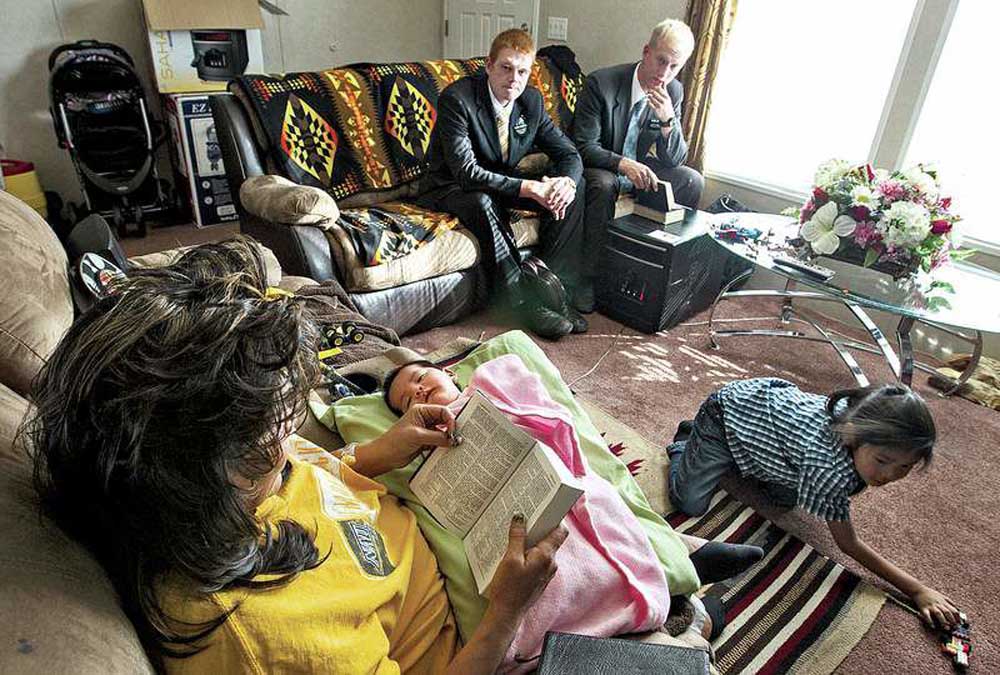For some, the path to Navajo values weaves through the Mormon church
Published 2:58 pm Saturday, November 16, 2013

- Nora Fowler reviews her copy of the Book of Mormon while church elders Porter Jones, left, and Gideon Coesens look on at her home in Tuba City, Ariz., last month. Fowler is among a growing number of Navajos who are turning to the Mormon Church in times of dysfunction and despair.
TUBA CITY, Ariz. — Linda Smith lost one son, a methamphetamine addict, when he hanged himself in jail. Her other sons are heavy drinkers, fathered by a man who she said nearly killed her one night in a fit of rage, driving her from her home on this corner of the Navajo reservation to Provo, Utah, where she found solace in the Mormon church.
Smith’s narrative echoes an increasingly common theme on this reservation, where unemployment is rampant, domestic violence is common, and alcohol is often used as an antidote to heartaches and hardships. In a land troubled by dysfunction and despair, a growing number of Navajo have been turning to the Mormon church.
Membership at the church’s Tuba City Stake, which covers 150 miles of Navajo and Hopi lands, has increased by 25 percent since 2008, even as churches around it have struggled. St. Jude Parish, this city’s sole Roman Catholic presence, survives largely because of its Filipino congregants, brought here to teach in the local public schools. In September, the Catholic Diocese of Gallup, N.M., which serves the Navajo Nation and six other reservations, filed for bankruptcy protection because of the mounting costs of defending against accusations of sexual abuse by clergy members.
To attract followers, Larry Justice, a white man who is the president of the Tuba City Stake, took a page from the lives of Navajo ancestors and began a gardening program to teach people how to live off the land.
He and a handful of church volunteers teach gardening techniques, distributing seeds from a plot behind the church building here. The program started with 25 gardens four years ago, each made by Navajo next to their homes. There were 1,800 gardens last month, and by next year 500 more are to be created in Tuba City and communities all around it, Justice said.
Participants learn how to fertilize the soil, parched by years of drought. They learn to build fences to keep out the animals that roam the land. They learn what to harvest and when: melons and grapes in the summer, squash and cabbage in the fall.
Aligned values
As converts here on the reservation tell it, becoming a Mormon has brought them closer to the fundamental Navajo values of charity, camaraderie and respect for the land.
There is a feeling of “reconnecting to our traditions,” as one of them, Nora Kaibetoney, explained in Navajo through a translator — even though Mormonism often compels them to leave behind rituals that have long defined their identity, like a medicine man’s healing ceremonies or the cleansing in sweat lodges.
“In Navajo culture, the most important things we have are life and our family,” said Smith, 64, the daughter of a Navajo Code Talker and hand trembler, a type of diagnostician. She was baptized as a Mormon in high school.
Converting, she said, “wasn’t about turning away and embracing an entirely different tradition; it was about reconnecting.”
American Indians have had complicated histories with the Christian denominations that have performed missionary work among them, including the Mormon church, known formally as the Church of Jesus Christ of Latter-day Saints. In the West, where Mormons migrated during the 19th century while fleeing persecution, they and the Navajo worked together on the land and also fought over it, in a relationship defined by alternating periods of cooperation and strife.
Descendants of Lamanites
What set the Mormons apart from other missionary groups is the role they ascribed to American Indians in their holy scriptures as descendants of the Lamanites — rebellious nonbelievers whose conversion could help the Mormons build God’s kingdom on earth.
“There’s this paradoxical sense in which the Lamanites are both a rebellious and wicked people, but they’re also key to the consummation of history and they’re central actors in the Mormon scriptural drama,” said Peter Thuesen, the chairman of the department of religious studies at Indiana University-Purdue University Indianapolis, whose research explores the role of Mormonism in American culture. “No other form of Christianity gives the native people such a unique place in their story.”
In paintings adorning the church’s building in Tuba City, a structure made striking by the modest homes that surround it, American Indians listen as Jesus preaches to them. According to Mormon belief, Indians were the first people to whom he ministered when he came to the Americas after his resurrection. The connection is one of the ways the church attracts people like Wayne Smith, whom Smith married last year in the church.
A retired ironworker, Smith, 52, is among the tens of thousands of American Indians, most of them Navajo, who were recruited as children for placement in Mormon homes outside the reservation, under a contentious program that was promoted as a way to give the children a chance at a good education — but that removed them from their native culture.
Smith recalled that the program gave him a sense of self-worth.
“Here was an outside group of people telling me I wasn’t just someone who was poor,” he said, “that I had a great heritage, that I have potential.”






